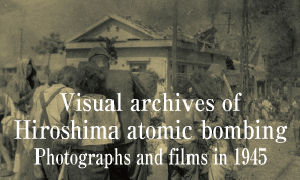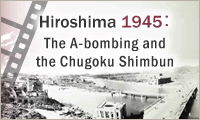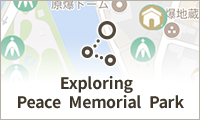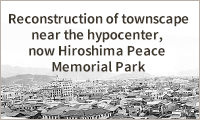Documenting Hiroshima of 1945: Mid-September, devastated physics research laboratory
Sep. 14, 2024
by Kyosuke Mizukawa, Senior Staff Writer
In mid-September 1945, a gatepost at a theoretical physics laboratory stood alone amidst the ruins of Hiroshima University of Literature and Science (present-day Hiroshima University), located around 1.6 kilometers southeast of the hypocenter of the atomic bombing. The lab was originally established in 1944. Yoshitaka Mimura, a theoretical physicist who was born in Takehara City, Hiroshima Prefecture and died in 1965 at the age of 67, served as director of the lab and led its pioneering research efforts.
In 1937, Mr. Mimura started serving as a professor at the university, garnering attention both in Japan and overseas for his research into wave geometry integrating quantum mechanics and relativity theory. On February 3, 1945, the Chugoku Shimbun newspaper carried an article of Mr. Mimura’s views on atomic bombs as a local expert.
At the time, Japan’s national newspapers carried articles that cast an eye to science as the key for Germany and Japan to defeat the United States, the United Kingdom, and the other Allied powers. The Chugoku Shimbun held a roundtable discussion on the topic of “scientific warfare,” with a focus on the atomic bomb. Mr. Mimura responded to the questions by speaking in general terms about his views. “It recently appears as if people prefer to focus on atomic bombs, but that is simply wishful thinking. Achieving their development would likely be exceedingly difficult.” He added, however, that “atoms have immense destructive energy.”
Roughly six months later, the U.S. military dropped an atomic bomb on Hiroshima. His lab building collapsed and was burned to the ground. Three faculty members in the lab died, and Mr. Mimura suffered wounds to his head.
Mr. Mimura and other lab members immediately considered the potential for development of an atomic bomb and put together survey procedures to investigate how realistic the plan was. However, a lab report issued in August 1945 indicated that, “Because several lab members have died or been severely injured in the bombing, we have almost no spare time. With that, it is regrettable that our lab is only able to conduct very small-scale studies.”
Even one month after the atomic bombing, there was no end in sight to the damage and destruction from radiation. To grasp the reality of the situation in Hiroshima, including the effects from the blast and thermal rays generated in the bombing, findings from numerous academic fields were required. On September 14, a Japan Ministry of Education academic research council established a special committee to survey the devastation caused by the atomic bombing. With that, full-fledged academic studies on the bombing had begun.
(Originally published on September 14, 2024)
In mid-September 1945, a gatepost at a theoretical physics laboratory stood alone amidst the ruins of Hiroshima University of Literature and Science (present-day Hiroshima University), located around 1.6 kilometers southeast of the hypocenter of the atomic bombing. The lab was originally established in 1944. Yoshitaka Mimura, a theoretical physicist who was born in Takehara City, Hiroshima Prefecture and died in 1965 at the age of 67, served as director of the lab and led its pioneering research efforts.
In 1937, Mr. Mimura started serving as a professor at the university, garnering attention both in Japan and overseas for his research into wave geometry integrating quantum mechanics and relativity theory. On February 3, 1945, the Chugoku Shimbun newspaper carried an article of Mr. Mimura’s views on atomic bombs as a local expert.
At the time, Japan’s national newspapers carried articles that cast an eye to science as the key for Germany and Japan to defeat the United States, the United Kingdom, and the other Allied powers. The Chugoku Shimbun held a roundtable discussion on the topic of “scientific warfare,” with a focus on the atomic bomb. Mr. Mimura responded to the questions by speaking in general terms about his views. “It recently appears as if people prefer to focus on atomic bombs, but that is simply wishful thinking. Achieving their development would likely be exceedingly difficult.” He added, however, that “atoms have immense destructive energy.”
Roughly six months later, the U.S. military dropped an atomic bomb on Hiroshima. His lab building collapsed and was burned to the ground. Three faculty members in the lab died, and Mr. Mimura suffered wounds to his head.
Mr. Mimura and other lab members immediately considered the potential for development of an atomic bomb and put together survey procedures to investigate how realistic the plan was. However, a lab report issued in August 1945 indicated that, “Because several lab members have died or been severely injured in the bombing, we have almost no spare time. With that, it is regrettable that our lab is only able to conduct very small-scale studies.”
Even one month after the atomic bombing, there was no end in sight to the damage and destruction from radiation. To grasp the reality of the situation in Hiroshima, including the effects from the blast and thermal rays generated in the bombing, findings from numerous academic fields were required. On September 14, a Japan Ministry of Education academic research council established a special committee to survey the devastation caused by the atomic bombing. With that, full-fledged academic studies on the bombing had begun.
(Originally published on September 14, 2024)






